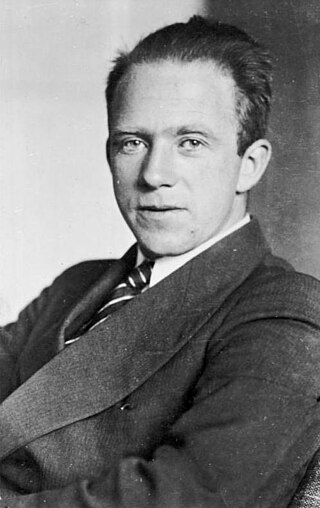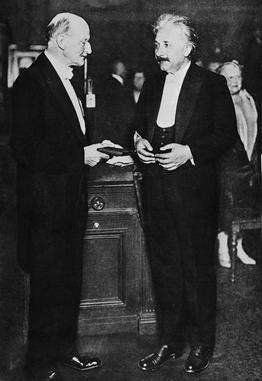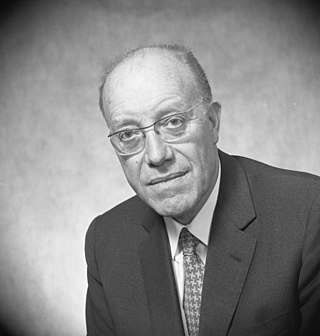
Werner Karl Heisenberg was a German theoretical physicist, one of the main pioneers of the theory of quantum mechanics, and a principal scientist in the Nazi nuclear weapons program during World War II. He published his Umdeutung paper in 1925, a major reinterpretation of old quantum theory. In the subsequent series of papers with Max Born and Pascual Jordan, during the same year, his matrix formulation of quantum mechanics was substantially elaborated. He is known for the uncertainty principle, which he published in 1927. Heisenberg was awarded the 1932 Nobel Prize in Physics "for the creation of quantum mechanics".

Walther Wilhelm Georg Bothe was a German nuclear physicist known for the development of coincidence methods to study particle physics.

Max Theodor Felix von Laue was a German physicist who received the Nobel Prize in Physics in 1914 for his discovery of the diffraction of X-rays by crystals.

The Max Planck Medal is the highest award of the German Physical Society (Deutsche Physikalische Gesellschaft), the world's largest organization of physicists, for extraordinary achievements in theoretical physics. The prize has been awarded annually since 1929, with few exceptions, and usually to a single person. The winner is awarded with a gold medal and hand-written parchment.

Carl Friedrich Freiherr von Weizsäcker was a German physicist and philosopher. He was the longest-living member of the team which performed nuclear research in Nazi Germany during the Second World War, under Werner Heisenberg's leadership. There is ongoing debate as to whether or not he and the other members of the team actively and willingly pursued the development of a nuclear bomb for Germany during this time.

Kurt Diebner was a German nuclear physicist who is well known for directing and administering parts of the German nuclear weapons program, a secretive program aiming to build nuclear weapons for Nazi Germany during World War II. He was appointed the project's administrative director after Adolf Hitler authorized it.
Ernst J. L. Gehrcke was a German experimental physicist. He was director of the optical department at the Reich Physical and Technical Institute. Concurrently, he was a professor at the University of Berlin. He developed the Lummer–Gehrcke method in interferometry and the multiplex interferometric spectroscope for precision resolution of spectral-line structures. As an anti-relativist, he was a speaker at an event organized in 1920 by the Working Society of German Scientists. He sat on the board of trustees of the Potsdam Astrophysical Observatory. After World War II, he worked at Carl Zeiss Jena, and he helped to develop and become the director of the Institute for Physiological Optics at the University of Jena. In 1949, he began work at the German Office for Materials and Product Testing. In 1953, he became the director of the optical department of the German Office for Weights and Measures.
The Max-Planck-Institut für Kernphysik is a research institute in Heidelberg, Germany.
Erich Schumann was a German physicist who specialized in acoustics and explosives, and had a penchant for music. He was a general officer in the army and a professor at the University of Berlin and the Technische Hochschule Berlin. When Adolf Hitler came to power he joined the Nazi Party. During World War II, his positions in the Army Ordnance Office and the Army High Command made him one of the most powerful and influential physicists in Germany. He ran the German nuclear energy program from 1939 to 1942, when the army relinquished control to the Reich Research Council. His role in the project was obfuscated after the war by the German physics community's defense of its conduct during the war. The publication of his book on the military's role in the project was not allowed by the British occupation authorities. He was director of the Helmholtz Institute of Sound Psychology and Medical Acoustics.
Karl Eugen Julius Wirtz was a German nuclear physicist, born in Cologne. He was arrested by the allied British and American Armed Forces and incarcerated at Farm Hall for six months in 1945 under Operation Epsilon.
Kernphysikalische Forschungsberichte was an internal publication of the German Uranverein, which was initiated under the Heereswaffenamt in 1939; in 1942, supervision of the Uranverein was turned over to the Reichsforschungsrat under the Reichserziehungsministerium. Reports in this publication were classified Top Secret, they had very limited distribution, and the authors were not allowed to keep copies. The reports were confiscated under the Allied Operation Alsos and sent to the United States Atomic Energy Commission for evaluation. In 1971, the reports were declassified and returned to Germany. Many of the reports are available at the Karlsruhe Nuclear Research Center and the Niels Bohr Library of the American Institute of Physics. Many of them are reprinted and transcribed in the book "Collected Works / Gesammelte Werke" listed below which is available in most libraries. There are reports numbered G-1 to G-395.
Friedrich Arnold "Fritz" Bopp was a German theoretical physicist who contributed to nuclear physics and quantum field theory. He worked at the Kaiser-Wilhelm Institut für Physik and with the Uranverein. He was a professor at the Ludwig Maximilian University of Munich and a President of the Deutsche Physikalische Gesellschaft. He signed the Göttingen Manifesto.
Johannes Wilhelm Heinrich Juilfs, also known by the alias Mathias Jules, was a German theoretical and experimental physicist. He was a member of the Sturmabteilung (SA) and then, in 1933, of the Schutzstaffel (SS). Prior to World War II, he was one of three SS staff physicists who investigated the physicist Werner Heisenberg during the Heisenberg Affair, instigated, in part, by the ideological Deutsche Physik movement. During the war, he worked as a theoretical physics assistant at the Kaiser Wilhelm Institute for Physics. During the denazification process after World War II, he was banned from working as a civil servant in academia. For a few years, he worked as a school principal, and then he took a job as a physicist in the textile industry. With the help of Heisenberg and the Minister of Lower Saxony, he was able to become a full professor at the Leibniz University Hannover.
Erich Horst Fischer was a German experimental physicist. He worked at the Kaiser Wilhelm Institute for Physics (KWIP) and contributed to the German nuclear energy project, also known as the Uranium Club. After World War II, he helped rebuild the KWIP branch at Hechingen, was a professor at the University of Tübingen and Ankara University, and then a research scientist for the German firm GKSS.

Heinz Maier-Leibnitz was a German physicist. He made contributions to nuclear spectroscopy, coincidence measurement techniques, radioactive tracers for biochemistry and medicine, and neutron optics. He was an influential educator and an advisor to the Federal Republic of Germany on nuclear programs.
Manfred Lindner is a German physicist and director at the Max Planck Institute for Nuclear Physics in Heidelberg, Germany. He conducts basic research in particle and astro-particle physics.
Werner Hofmann is a German professor of physics. He is director of the Max Planck Institute for Nuclear Physics in Heidelberg.
Allen Caldwell is one of currently seven directors of the Max Planck Institute for Physics. He became director in 2002.
Sigfried Bethke is a German physicist and science manager.






